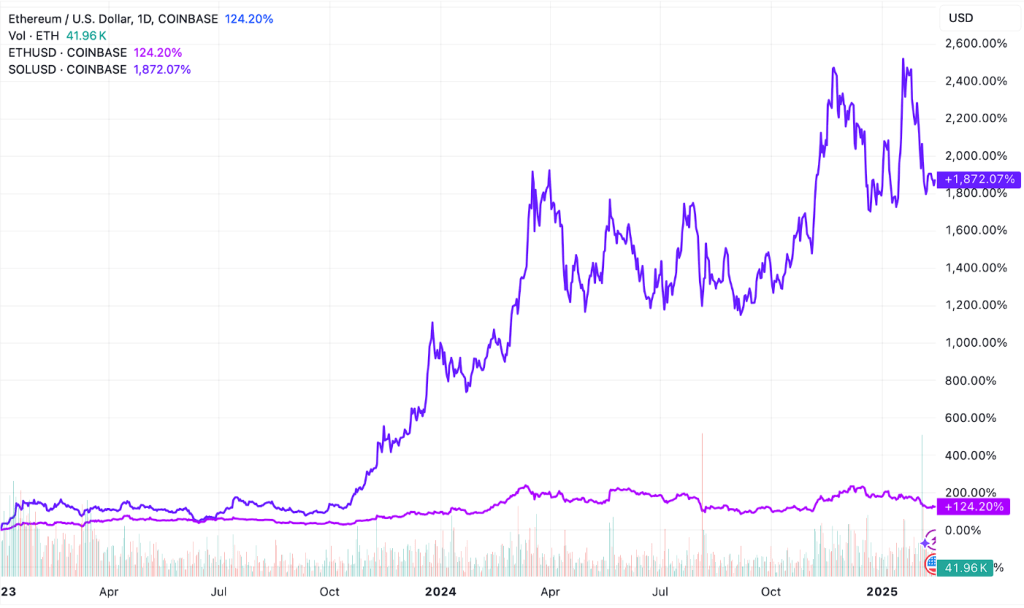Solana vs Ethereum: Choosing the Right Blockchain for Your dApp

The blockchain you build on could define how fast you grow, how much you spend, and how secure your platform really is. That’s why blockchain decisions aren’t just for developers anymore; they’re shaping business strategy.
Choosing between Solana Vs Ethereum is not easy, as it changes the shape of the infrastructure, when it comes down to critical factors such as adoption, scalability, and cost.
At ServerMania, we don’t just host blockchain infrastructure; we help you build the future of Web3. With over two decades of experience powering high-availability workloads, we’ve become a trusted partner for developers, founders, and enterprises scaling dApps and protocols across the globe.
Whether you’re deploying validators on our robust Blockchain Servers or spinning up low-latency nodes, we’re here to give your project the backbone it needs. That’s why in this thorough guide, we’ll walk you through a complete comparison of Solana and Ethereum blockchains.
See Also: What is Blockchain Node Hosting and How Does it Work?
Importance of Choosing Between Solana Vs Ethereum
Choosing the wrong blockchain platform today may be one of the biggest mistakes for both developers and Web3 entrepreneurs alike. That’s why knowing why this choice is so important is vital, especially when the stakes are in the millions.
For example, in 2025 alone, applications built on the Solana blockchain generated the stunning $571 million in revenue, outpacing Ethereum’s $200 million. That statistic alone is forcing developers and investors to have a second thought due to the possibility of producing monster returns.

Image Source: Fool.com
The Solana ecosystem is attracting serious attention for its performance gains and lower cost structure, making it a tempting choice to buy stock. In turn, Ethereum is still the heavyweight champion of the institutional trust, tooling, and market cap.
As enterprise adoption accelerates and infrastructure demands grow, choosing between Solana and Ethereum is no longer just about dev preference; it’s a business decision.
Developer migration trends are shifting, and once unchallenged platforms are now seeing competition from faster, cheaper alternatives. So, let’s move on and break down the key metrics, scalability factors, costs, and infrastructure realities you’ll need to consider before committing your newest Web3 projects.
KEY DIFFERENCES:
Solana uses a monolithic architecture with Proof-of-History (PoH) consensus to achieve high throughput on a single layer, while Ethereum employs a modular approach with Proof-of-Stake (PoS) consensus and Layer 2 scaling solutions to maintain decentralization while improving performance.
Solana Overview
Solana has come a long way and carved its way into the blockchain ecosystem by providing some of the greatest advantages the industry has ever seen. While Solana provides ultra-fast performance and the lowest fees that we’ve seen so far, the most important factor remains scalability.
At first glance, if we want to compare Ethereum vs Solana accurately, it’s necessary to verify and understand the things you gain and the things you must give up.
Solana Advantages
Solana’s advantages stem from a design focused on resolving bottlenecks and addressing the limitations of Ethereum. This focus has helped Solana’s network to become one of the fastest blockchains in decentralized finance, gaming, and NFTs.
Let’s go over some of the standout advantages:
| ✅ Solana Advantage | |
|---|---|
| Transaction Speed | Solana handles more than 65,000+ transactions per second (TPS), which is much more than Ethereum’s base layer. |
| Lowest Fees So Far | The revolutionary architecture and the consensus mechanism allow Solana to offer an average of less than $0.01 per transaction cost. |
| Monolithic Design | Unlike the Ethereum blockchain, Solana uses a single-layer chain, meaning execution to settlement happens in one layer. |
| Rust and C Support | Developers can write smart contracts in Rust or C, giving low-level access to performance optimization and easing the transition for Web2 devs. |
| Strong Ecosystem | With rising app revenue, increasing TVL, and institutional attention, the Solana ecosystem has become a serious contender in the crypto market. |
Note: Transaction fees on Ethereum tend to be higher due to network congestion and gas prices (fees paid to process transactions) fluctuating with demand, including an exchange commission that users should factor in.
Solana Disadvantages
Sadly, speed isn’t everything. While Solana comes with a lot of pros, there are some disadvantages that we can’t overlook. Let’s explore the downsides:
| ❌ Solana Limitations | |
|---|---|
| Outages and Downtime | Solana has experienced several major outages due to congestion and validator node issues—something that hasn’t occurred on Ethereum’s base layer. |
| Hardware Requirements | Running a validator node on Solana requires extremely powerful server hardware, significantly increasing infrastructure costs. |
| Tooling & Documentation | Solana still lags behind Ethereum in developer tools and educational resources, despite its rapid growth. |
| Centralization Concerns | A smaller validator set and reliance on high-performance hardware have raised concerns about Solana being more centralized than Ethereum. |
| Smart Contract Immaturity | Solana’s smart contract ecosystem lacks the mature security practices and composability found in Ethereum’s long-standing EVM environment. |
Ethereum Overview
Ethereum is more than a blockchain; it’s the birth of decentralized applications dApps as we know them today, and it’s still the largest developer ecosystem. So, even if outphased by Solana, Ethereum remains the no-brainer choice for teams working with Web3 projects.
Let’s explore what dominance Ethereum still holds against Solana:
Ethereum Advantages
There’s a reason why Ethereum continues to attract a large share of developers, capital, and enterprise partnerships, maintaining a strong market share in the blockchain space.
| ✅ Ethereum Advantages | |
|---|---|
| Smart Contract Ecosystem | No other chain rivals Ethereum’s depth in smart contract functionality, which ensures robust security and tooling for complex dApp development. |
| Deep Liquidity and Effects | DeFi protocols, NFT marketplaces, and major capital flows are already rooted in Ethereum, making it the financial hub of Web3—even in 2025. |
| Institutional Popularization | Ethereum is widely viewed as the “safest” blockchain by VCs, enterprises, and even regulatory bodies like the SEC. |
| Continuous Improvements | Ethereum’s roadmap—including rollups and Ethereum 2.0—aims to scale the network while preserving its decentralized foundation. |
| Big Developer Mindshare | Ethereum remains the most actively supported platform among developers, with thriving communities, countless repos, and a global hackathon presence. |
Ethereum Disadvantages
With the major Ethereum advantages being said, there is a handful of cons that Solana overcomes, leading to the latest headlines. A few downsides to consider include:
| ❌ Ethereum Limitations | |
|---|---|
| Unexpected Fee Spikes | During peak demand, Ethereum’s gas fees can become extremely volatile, leading to unpredictable validator costs and a poor user experience. |
| Slower Layer Throughput | Ethereum’s base layer is limited to ~15–30 TPS without rollups, which can bottleneck performance for larger-scale or enterprise applications. |
| Layer 2 Adds Complexity | While rollups (like Arbitrum and Optimism) improve scalability, they introduce bridging friction, new trust assumptions, and fragmented UX. |
| Slow Development Pace | Due to Ethereum’s decentralized governance, crucial upgrades often take years, slowing down innovation and adaptation. |
| Higher Infrastructure Costs | Running apps on both the Ethereum mainnet and L2s can increase DevOps complexity and total infrastructure expenses for projects with large workloads. |
Solana vs Ethereum: Tools, Frameworks, and SDKs Compared
Choosing between Solana and Ethereum isn’t just about performance or cost; it’s also about how easy and efficient it is to build, test, and deploy applications.
Let’s break down the developer ecosystems of both blockchains and highlight the tools, SDKs, and frameworks developers actually rely on.
| Feature / Tool | Ethereum | Solana |
|---|---|---|
| Development Framework | Hardhat – Plugin-based Ethereum dev environment | Anchor – Framework simplifying Rust development |
| Browser IDE | Remix IDE – In-browser Solidity editor | Solana Playground – In-browser Solana program editor |
| Smart Contract Libraries | OpenZeppelin – Secure, reusable contract templates | Built-in with Anchor – IDL support, macros, and program structure |
| Client SDKs (JavaScript) | Web3.js, Ethers.js – Node interaction | @solana/web3.js – Solana’s core JavaScript SDK |
| Client SDKs (Other Languages) | Web3.py – Python SDK | Solanaj – Java SDK |
| Testing Tools | Mocha, Chai, Waffle | Built-in Anchor testing (Mocha-style); Solana Test Validator |
| CLI Tools | Foundry or Hardhat CLI | Solana CLI – For deployment, testing, and key management |
| Alternative Language Support | Solidity (primary), Vyper (experimental) | Rust (primary), Seahorse for Python-based development |
Use Cases for Solana and Ethereum
By now, we all know that not every blockchain is built to work with every single workflow in the same way. So, the best way to choose between Solana and Ethereum would be to consider your workload and, based on the advantages and disadvantages, make the best choice.
DeFi Applications
If you’re building a complex DeFi protocol with cross-chain integrations, composability, and institutional capital in mind, Ethereum is the natural choice.
Its battle-tested smart contracts, deep liquidity, and regulatory momentum, including the potential of Ethereum ETFs and emerging Solana ETFs, make it ideal for long-term financial infrastructure. On the other hand, Solana would be a great fit for DeFi apps that require high-frequency trading or microtransactions.
This is thanks to its low fees and lightning-fast transaction speeds!
NFT Marketplaces
Creators who prioritize low minting costs and smoother UX often go with Solana. But if prestige, security audits, or interoperability with major NFT ecosystems matter more, Ethereum still leads.
Gaming and Tech
Solana’s performance gives it the edge for real-time blockchain gaming or social decentralized applications (dApps), so any use case where speed, cost, and scalability are critical.
In turn, Ethereum could struggle here unless Layer 2s are involved, which adds complexity.
Enterprise Projects
Ethereum remains the go-to for large enterprises due to its mature tooling, legal clarity, and strong community of infrastructure providers. However, with the market crushing outperformance from Solana in 2025, things might change in the future.
Infrastructure and Hosting Requirements: Key Metrics
Running production-grade infrastructure for a blockchain project is different than spinning up a simple web server. Hence, whether you are deploying validators, RPC endpoints, or full archival nodes, the infrastructure demands behind Solana and Ethereum can quickly become a core part of your project’s burn rate and performance profile.
Here are several key metrics:
Node Hardware Requirements & Specifications
In practice, Solana and Ethereum are quite different in how they operate. Solana’s validator nodes are performance-heavy by design, while Ethereum’s requirements depend heavily on whether you’re operating on the base layer or a Layer 2 rollup.
| Blockchain | Node Type | CPU | RAM | Storage Type | SSD Space |
|---|---|---|---|---|---|
| Solana | Validator | 16–32 core (AVX2) | 128 GB+ | NVMe | 1–2 TB |
| Solana | RPC/Full Node | 12–16 core | 64–128 GB | NVMe | 1–2 TB |
| Ethereum | Consensus Node | 4–8 core | 16–32 GB | SSD | 1 TB+ |
| Ethereum | Execution Node | 8–16 core | 32–64 GB | SSD/NVMe | 1–2 TB |
For instance, Solana validators require high-performance CPUs with the AVX2 extension and high RAM support, which can instantly eliminate virtual machines. In turn, Ethereum’s architecture is more flexible but often split across multiple node types, especially for those interacting with both execution layers.
See Also: How to Host a Solana Validator Node
Bandwidth and Storage Considerations
Bandwidth is often overlooked until it breaks something in production. Solana’s validators can consume up to 500 Mbps or more during peak activity. Ethereum nodes are less bandwidth-intensive but require consistent throughput and reliable connectivity, especially during sync operations. To avoid surprises (and overage fees), an unmetered-bandwidth plan gives you the headroom to handle traffic surges without throttling.
Storage demands also grow over time. Solana’s ledger data is large and constantly expanding, meaning you’ll need fast NVMe SSDs with high write endurance. In turn, Ethereum, particularly archival nodes, can require multiple terabytes if you’re storing the full chain history.
Geographic Distribution and Optimization
Where your nodes live matters the most, especially for latency-sensitive applications like DeFi or real-time trading platforms. Solana’s cluster design and Ethereum’s validator reward mechanics both benefit from well-distributed nodes across regions like North America, Europe, and Asia.
We help clients reduce latency and improve failover by leveraging our global data center footprint. With smart load balancing, disaster recovery options, and multi-region deployment strategies, ServerMania ensures your nodes aren’t just live, they’re performing at their peak.
Performance Comparison: TPS, Throughput, and Scalability
When you’re constructing dApps or DeFi protocols, the raw performance is critical, so let’s break down some of the real performance numbers and how Solana and Ethereum compare against each other.
Solana Vs Ethereum TPS
| Real‑Time TPS | Max TPS (100‑block burst) | Theoretical Max TPS | |
|---|---|---|---|
| Solana | 1,293 (avg) / 1,558 peak | 2,909 | 65,000 |
| Ethereum L1 | ~18 TPS | ~62 TPS burst? | N/A |
Source: https://chainspect.app/
Block Time & Finality Analysis
Speed isn’t just about transactions per second; it’s how long users wait for confirmation.
- Solana’s blocks finalize in ~0.4 seconds, with full finality in about 12.8 seconds
- Ethereum’s block time is around 12 seconds, and finality can stretch into minutes.
Network Congestion Handling
In real-world loads with NFT drops or DeFi spikes, Solana’s architecture handles bursts smoothly. For example, during Q2 2025, the network averaged 1,504 TPS during heavy activity, even as transaction costs remained ultralow.
Ethereum, by contrast, suffers from visible congestion: gas fees spike and queue times balloon. Its scalability relies on Layer 2 solutions, which add even more complexity and friction, though upcoming improvements aim to address these pain points.
What’s Next for Blockchain Technology
One thing is clear. Both Ethereum and Solana are rolling out upgrades aimed at making their platforms more maintainable.
However, both are tackling key challenges from very different angles, so let’s check some changes in the coming years to identify which is a better option.
Ethereum’s Proto‑Danksharding
The landmark Dencun upgrade, released in March 2024, introduced Proto‑Danksharding (EIP‑4844). It adds “blob‑carrying transactions” that allow Layer‑2 rollups to post data cheaply and temporarily, significantly lowering gas fees and increasing throughput.
We expect this to reduce the rollup costs significantly, while developers are already seeing up to 90% fee reduction during peak. Plans through Pectra (May 6, 2025), and later Danksharding aim to push Ethereum closer to 100,000+ TPS by restructuring data availability and validator.
Solana’s Firedancer Upgrade
Solana’s most anticipated development is the Firedancer Calidator Client, expected for mainnet launch in 2025 after testnet phases in 2023–24.
It’s developed in C++ by Jump Crypto and Firedancer promises dramatically improved performance, client diversity (reducing single-client risk), and potential TPS beyond 1 million under ideal conditions.
The roadmap also includes doubling Solana’s blockspace, from ~48M to up to 60M compute units, and improvements to read-layer infrastructure (RPS 2.0), scheduling, and the consensus mechanisms.

Choose ServerMania to Host Solana & Ethereum Infrastructure
When it comes down to owning a production-ready infrastructure, whether you’re looking for Solana or Ethereum, here at ServerMania, we’ve got you covered. Our purpose-built solutions are optimized for the unique demands of blockchain networks.
At ServerMania, every deployment includes:
- Real-time monitoring
- Expert 24/7 support
- Automated backup and disaster recovery
We also offer scalable and cost-effective architecture with security and compliance built in. If you would like to learn more, book a free consultation with a ServerMania expert today and get started.
Was this page helpful?

